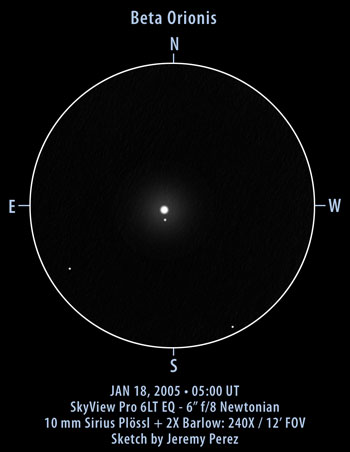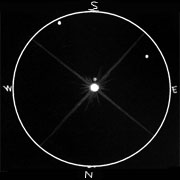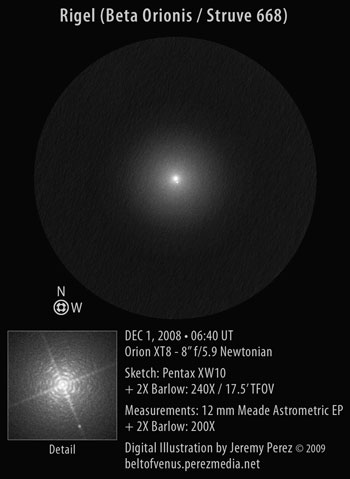Observation Notes:
Rigel really makes a beautiful pair. The effect of the brilliant primary glaring across its subdued companion is striking. The secondary does hold its own though, and even though the diffraction spikes cut straight across it, it was still visible.
| Subject | Rigel (Beta Orionis / STF 668) |
| Classification | Multiple Star |
| Position (J2000)* | Orion [RA: 05:14:32.3 / Dec: -08:12:05] |
| Position Angle | 202° [My Measurement 2008.9] 201° [WDS 1822]* |
| Separation | 11.2″ [My Measurement 2008.9] 9.5″ [WDS 1822]* |
| Magnitudes* | 0.3 / 6.8 |
| Spectral Types* | A: B8I; B: B8II |
| Date/Time | NOV 30, 2008 – 11:40 PM (DEC 1, 2008 – 06:40 UT) |
| Observing Loc. | Flagstaff, AZ – Home |
| Instrument | Orion SkyQuest XT8 Dobsonian (203 mm dia./1200 mm F/L) |
| Eyepieces/Mag. | Pentax XW10 + 2X Barlow (240X) Meade Astrometric EP + 2X Barlow (200X) |
| Conditions | Clear, cool, breezy |
| Seeing | 5/10 Pickering |
| Transparency | Mag 6.0 NELM |
| *References | The Washington Visual Double Star Catalog (Mason+ 2001-2009); Catalogue of Stellar Spectral Classifications (Skiff, 2009); SIMBAD |
January 17, 2005 Observation

October 10, 2006: To help provide a consistent style for my double star sketches, the above sketch is a digital update to the original sketch.

Observation Notes:
Rigel is incredibly bright, with diffraction spikes reaching to the edge of the view. The companion star appears close and directly south of Rigel. The seeing is pretty crummy, but the companion still shows up. Fortunately, the spider vanes were turned to the perfect angle to let it show between them.
| Date/Time | JAN 17, 2005 – 10:00 PM (JAN 18, 2005 – 05:00 UT) |
| Observing Loc. | Flagstaff, AZ – Home |
| Instrument | Orion SVP 6LT Reflector (150 mm dia./1200 mm F/L) |
| Eyepieces/Mag. | 10 mm + 2X Barlow (240X) |
| Conditions | Clear, cool (39°F), 1st quarter Moon |
| Seeing | 3/10 Pickering |
| Transparency | Mag 5.2 NELM |
*Based on published data.

Really impressive work on Rigel and your site is very inspiring. I like very mutch the halo in the main image and the close up is also really realistic. Do you draw the close up entirely at the eyepiece or do you use some digital tecnique later at home, or may be both?
Marco, thanks, that’s a great question. When making my eyepiece sketches, I do several things:
1) First, I make a sketch showing the double star and any other field stars in the eyepiece.
2) Then I make a second close-up sketch where I diagram the position of the double stars along with the basic structure of the diffraction pattern and any prominent diffraction spikes.
3) Next, I take measurements of separation and position angle with my astrometric eyepiece and make notes of any color.
4) Then, some time later after I’m finished, I do a little research with Vizier and SIMBAD to find the actual magnitudes of the stars and compare other details.
This scanned log sheet shows what my double star observations and sketches tend to look like: Double Star Log Entry. The Gamma LEO entry shows basically how I draw the close-up view. Although with Rigel, this was a lot messier looking.
To produce the finished image, I scan the sketch and use it as a template to build a digital illustration in Photoshop. I’ve tested and set up a table that describes brush size and opacity for each stellar magnitude so I can create them consistently in all illustrations. For the close-up with the diffraction pattern, I have another series of steps and templates I’ve built. I work with this, using masks and brushes to match what I drew.
At some point, I plan to prepare a tutorial that describes this more recent process. Until then, I do have an older version here: Double Star Skething and Digitizing
I hope that helps. Please let me know if you have any other questions!
Jeremy